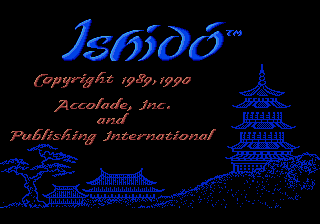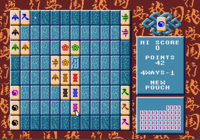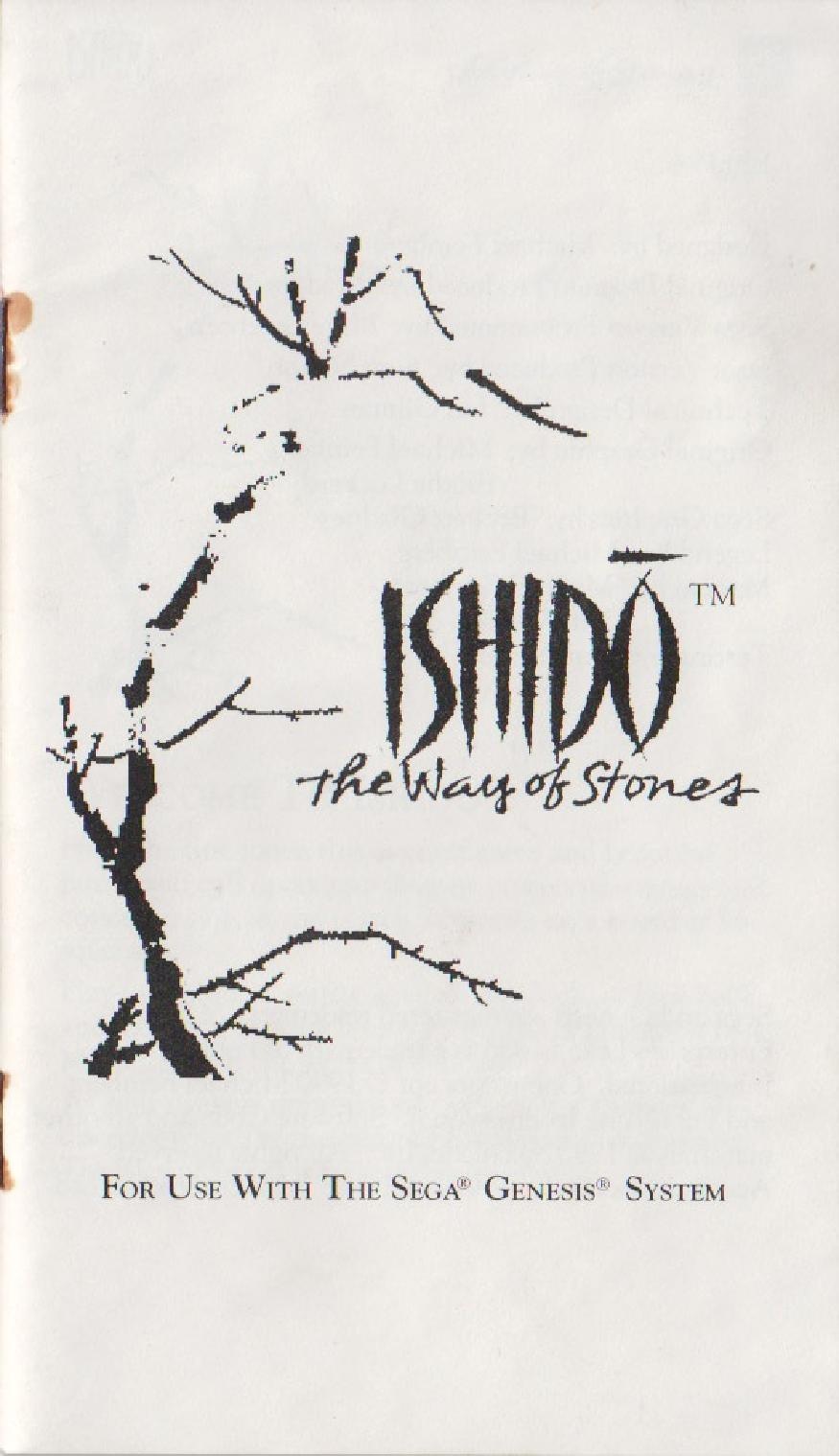Difference between revisions of "Ishido: The Way of Stones"
From Sega Retro
m (this summary could be better) |
|||
| (29 intermediate revisions by 12 users not shown) | |||
| Line 1: | Line 1: | ||
| − | |||
{{Bob | {{Bob | ||
| − | | bobscreen= | + | | bobscreen=IshidoTheWayOfStones MDTitleScreen.png |
| publisher=[[Accolade]] | | publisher=[[Accolade]] | ||
| − | | developer=[[Accolade]] | + | | developer=[[Accolade]] |
| + | | licensor=Publishing International | ||
| system=[[Sega Mega Drive]] | | system=[[Sega Mega Drive]] | ||
| − | | | + | | originalsystem=[[Macintosh]] |
| + | | sounddriver= | ||
| + | | peripherals= | ||
| + | | players=1 | ||
| + | | genre=Puzzle | ||
| releases={{releasesMD | | releases={{releasesMD | ||
| − | | md_date_us=1990 | + | | md_date_us=1990-12{{ref|https://groups.google.com/g/rec.games.video/c/cEccyoEu3ZU/m/VfsA-OX7ByIJ}} |
| + | | md_date_es=199x | ||
| + | }} | ||
| + | | otherformats={{NonSega|Amiga|IBMPC|FMTOWNS|GB|J3100|LYNX|Mac|MSX2|FDS|PC8801mkIISR|PC9801UV|X68}} | ||
| + | }} | ||
| + | '''''Ishidó: The Way of Stones''''' is an [[Sega Mega Drive]] puzzle game developed and published by [[Accolade]]. A port of Publishing International's 1990 [[wikipedia:Ishido: The Way of Stones|Macintosh game by the same name]], it was released exclusively in the United States in December of that year. | ||
| + | |||
| + | It is one of few commercially-released Sega Mega Drive games to fail the system's [[TradeMark Security System]] test (refusing to operate with anything but the earliest Mega Drive hardware), and was technically released without a license due to Accolade's decision to [[Sega v. Accolade|reverse-engineer TMSS without Sega of America's approval]]. | ||
| + | |||
| + | ==Story== | ||
| + | The game purports to be based on an ancient board game, discovered in the ruins of several lost civilizations. Included is a 30-page booklet with a story of a Chinese monk named Fei Mi-jai who meets a Western "sorcerer" and recounts to him the legend of the "Ancient Game of Stones." | ||
| + | {{quote|The Chinese called it ''Shih Tao'', the ancient Celts called it ''Runa futhark'', the Mayan Indians called it ''Kami-a-hota'', and the Japanese called it ''Ishidó''. Yet, regardless of origin, when translated the names all mean one thing, ''The Way of Stones''. | ||
| + | | US booklet | ||
| + | | ref={{fileref|The Way of Stones US Book.pdf|page=8}} | ||
}} | }} | ||
| − | | | + | However, the history and the legend (as well as the supposedly Japanese word "Ishidó") are fabricated. |
| + | |||
| + | ==Gameplay== | ||
| + | {{ScreenThumb|Ishido MD, Gameplay.png|width=200|Gameplay}} | ||
| + | ''Ishido'' is a puzzle board game, played on a board that is eight spaces high by twelve spaces wide. The player is given pieces, called stones, one at a time in a randomized order. Every stone has two characteristics: a color and a symbol. There are six colors and six symbols in each stone set, creating 36 unique stones. Each stone comes in a pair, for a total of 72 stones in each stone set. The goal of the game is to place all 72 stones onto the game board of 96 spaces. Stones must be placed adjacent to others that they match, either by color or symbol, according to certain rules. As the board fills with stones, these rules becomes more difficult to meet. | ||
| + | |||
| + | The game uses a cursor that can be moved across the board using the D-Pad. The player grabs a stone by moving the cursor to the "touchstone" in the top-right of the screen (without pressing any other buttons). The player can then move the cursor back onto the board and place the stone in any valid space with {{A}}. | ||
| + | |||
| + | The player can open a game menu with {{Start}} with options to start a new game or restart the current game (with the same randomized order for the stones). The player can open a help menu with {{C}} containing options to show the "pouch" (showing all of the remaining stones in order, with their colors and symbols) or show all possible moves (if the player is stuck). Using either form of assistance foregoes the opportunity to replace the high score. The game shows the number of stones remaining in the pouch (though not their color or symbol) in the bottom-right corner of the screen. There are multiple differently themed stone sets, which can be cycled with {{B}}. | ||
| + | |||
| + | ===Rules=== | ||
| + | Stones can only be placed according to these rules: | ||
| + | |||
| + | *When a stone is placed adjacent to one other stone, it must match by either color or symbol. This is called a 1-Way and worth 1 point. | ||
| + | *When a stone is placed adjacent to two stones, it must match one by color and the other by symbol. This is called a 2-Way and worth 2 points. | ||
| + | *When a stone is placed adjacent to three stones, it must match two stones by one attribute and one stone by the other attribute. This is called a 3-Way and worth 4 points. | ||
| + | *When a stone is placed adjacent to four stones, it must match two stones by color and two stones by symbol. This is called a 4-Way and worth 8 points. | ||
| + | |||
| + | Each 4-Way successfully placed doubles the scoring for the rest of the game, so creating as many 4-Ways as possible as early as possible is key to achieving a high score. | ||
| + | |||
| + | The board has two sections: the Within, which are the light-colored spaces that comprise the majority of the board, and the Beyond, which are the dark-colored spaces that form the perimeter. Only matches made in the Within award points. | ||
| + | |||
| + | Every game starts with two stones already placed in the center of the board and four stones placed in the four corners of the board. Each of the six opening stones has a different symbol and color, so that any other stone can be placed in a valid way according to these rules. | ||
| + | |||
| + | ==History== | ||
| + | ===Release=== | ||
| + | The game is the first unlicensed game produced by Accolade for the Mega Drive and thus formed the basis for the [[Sega v. Accolade]] lawsuit. | ||
| + | |||
| + | ==Production credits== | ||
| + | {{creditstable| | ||
| + | *'''Designed by:''' Michael Feinberg | ||
| + | *'''Original Program Produced by:''' Brad Fregger | ||
| + | *'''Sega Version Programmed by:''' Mike Lorenzen | ||
| + | *'''Sega Version Produced by:''' Sam Nelson | ||
| + | *'''Technical Design by:''' Ian Gilman | ||
| + | *'''Original Graphic by:''' Michael Feinberg, Brodie Lockard | ||
| + | *'''Sega Graphics by:''' Beckett Gladney | ||
| + | *'''Legend by:''' Michael Feinberg | ||
| + | *'''Manual by:''' Michael Feinberg, Jeff Wagner | ||
| + | *'''Testing by:''' Sam Nelson | ||
| + | | source=US manual | ||
| + | | pdf=Ishido MD US Manual.pdf | ||
| + | | pdfpage=2 | ||
| + | | console=MD | ||
}} | }} | ||
| − | |||
| − | + | ==Magazine articles== | |
| + | {{mainArticle|{{PAGENAME}}/Magazine articles}} | ||
==Physical scans== | ==Physical scans== | ||
| − | {{ratings | + | {{ratings|MD}} |
| − | | | ||
| − | |||
| − | |||
| − | |||
| − | |||
| − | |||
| − | |||
| − | |||
| − | |||
| − | }} | ||
{{Scanbox | {{Scanbox | ||
| console=Mega Drive | | console=Mega Drive | ||
| region=US | | region=US | ||
| front=Ishido MD US Box Front.jpg | | front=Ishido MD US Box Front.jpg | ||
| + | | back=Ishido MD US Box Back.jpg | ||
| + | | spinemissing=yes | ||
| cart=Ishido MD US Cart.jpg | | cart=Ishido MD US Cart.jpg | ||
| manual=Ishido MD US Manual.pdf | | manual=Ishido MD US Manual.pdf | ||
| + | | item1=The Way of Stones US Book.pdf | ||
| + | | item1name=Book | ||
| + | }} | ||
| + | {{Scanbox | ||
| + | | console=Mega Drive | ||
| + | | region=ES | ||
| + | | front=Ishido MD US Box Front.jpg | ||
| + | | back=Ishido MD US Box Back.jpg | ||
| + | | spinemissing=yes | ||
| + | | cart=Ishido MD US Cart.jpg | ||
| + | | manual= | ||
}} | }} | ||
==Technical information== | ==Technical information== | ||
| − | + | {{mainArticle|{{PAGENAME}}/Technical information}} | |
| − | {{ | ||
| − | {{ | ||
| − | }} | ||
==References== | ==References== | ||
| Line 45: | Line 105: | ||
<references/> | <references/> | ||
| + | {{IshidoOmni}} | ||
[[Category:Unlicensed Mega Drive games]] | [[Category:Unlicensed Mega Drive games]] | ||
Latest revision as of 18:55, 5 January 2025
| Ishido: The Way of Stones | |||||||||||||||
|---|---|---|---|---|---|---|---|---|---|---|---|---|---|---|---|
| System(s): Sega Mega Drive | |||||||||||||||
| Publisher: Accolade | |||||||||||||||
| Developer: Accolade | |||||||||||||||
| Licensor: Publishing International | |||||||||||||||
| Original system(s): Macintosh | |||||||||||||||
| Genre: Puzzle | |||||||||||||||
| Number of players: 1 | |||||||||||||||
| |||||||||||||||
|
Ishidó: The Way of Stones is an Sega Mega Drive puzzle game developed and published by Accolade. A port of Publishing International's 1990 Macintosh game by the same name, it was released exclusively in the United States in December of that year.
It is one of few commercially-released Sega Mega Drive games to fail the system's TradeMark Security System test (refusing to operate with anything but the earliest Mega Drive hardware), and was technically released without a license due to Accolade's decision to reverse-engineer TMSS without Sega of America's approval.
Contents
Story
The game purports to be based on an ancient board game, discovered in the ruins of several lost civilizations. Included is a 30-page booklet with a story of a Chinese monk named Fei Mi-jai who meets a Western "sorcerer" and recounts to him the legend of the "Ancient Game of Stones."
| “ | The Chinese called it Shih Tao, the ancient Celts called it Runa futhark, the Mayan Indians called it Kami-a-hota, and the Japanese called it Ishidó. Yet, regardless of origin, when translated the names all mean one thing, The Way of Stones. | „ |
— US booklet [2] | ||
However, the history and the legend (as well as the supposedly Japanese word "Ishidó") are fabricated.
Gameplay
Ishido is a puzzle board game, played on a board that is eight spaces high by twelve spaces wide. The player is given pieces, called stones, one at a time in a randomized order. Every stone has two characteristics: a color and a symbol. There are six colors and six symbols in each stone set, creating 36 unique stones. Each stone comes in a pair, for a total of 72 stones in each stone set. The goal of the game is to place all 72 stones onto the game board of 96 spaces. Stones must be placed adjacent to others that they match, either by color or symbol, according to certain rules. As the board fills with stones, these rules becomes more difficult to meet.
The game uses a cursor that can be moved across the board using the D-Pad. The player grabs a stone by moving the cursor to the "touchstone" in the top-right of the screen (without pressing any other buttons). The player can then move the cursor back onto the board and place the stone in any valid space with ![]() .
.
The player can open a game menu with START with options to start a new game or restart the current game (with the same randomized order for the stones). The player can open a help menu with ![]() containing options to show the "pouch" (showing all of the remaining stones in order, with their colors and symbols) or show all possible moves (if the player is stuck). Using either form of assistance foregoes the opportunity to replace the high score. The game shows the number of stones remaining in the pouch (though not their color or symbol) in the bottom-right corner of the screen. There are multiple differently themed stone sets, which can be cycled with
containing options to show the "pouch" (showing all of the remaining stones in order, with their colors and symbols) or show all possible moves (if the player is stuck). Using either form of assistance foregoes the opportunity to replace the high score. The game shows the number of stones remaining in the pouch (though not their color or symbol) in the bottom-right corner of the screen. There are multiple differently themed stone sets, which can be cycled with ![]() .
.
Rules
Stones can only be placed according to these rules:
- When a stone is placed adjacent to one other stone, it must match by either color or symbol. This is called a 1-Way and worth 1 point.
- When a stone is placed adjacent to two stones, it must match one by color and the other by symbol. This is called a 2-Way and worth 2 points.
- When a stone is placed adjacent to three stones, it must match two stones by one attribute and one stone by the other attribute. This is called a 3-Way and worth 4 points.
- When a stone is placed adjacent to four stones, it must match two stones by color and two stones by symbol. This is called a 4-Way and worth 8 points.
Each 4-Way successfully placed doubles the scoring for the rest of the game, so creating as many 4-Ways as possible as early as possible is key to achieving a high score.
The board has two sections: the Within, which are the light-colored spaces that comprise the majority of the board, and the Beyond, which are the dark-colored spaces that form the perimeter. Only matches made in the Within award points.
Every game starts with two stones already placed in the center of the board and four stones placed in the four corners of the board. Each of the six opening stones has a different symbol and color, so that any other stone can be placed in a valid way according to these rules.
History
Release
The game is the first unlicensed game produced by Accolade for the Mega Drive and thus formed the basis for the Sega v. Accolade lawsuit.
Production credits
- Designed by: Michael Feinberg
- Original Program Produced by: Brad Fregger
- Sega Version Programmed by: Mike Lorenzen
- Sega Version Produced by: Sam Nelson
- Technical Design by: Ian Gilman
- Original Graphic by: Michael Feinberg, Brodie Lockard
- Sega Graphics by: Beckett Gladney
- Legend by: Michael Feinberg
- Manual by: Michael Feinberg, Jeff Wagner
- Testing by: Sam Nelson
Magazine articles
- Main article: Ishido: The Way of Stones/Magazine articles.
Physical scans
| ExpandSega Retro Average |
|---|
| 70 | |
|---|---|
| Based on 11 reviews | |
Technical information
- Main article: Ishido: The Way of Stones/Technical information.
References
NEC Retro has more information related to Ishido: The Way of Stones
|
- ↑ https://groups.google.com/g/rec.games.video/c/cEccyoEu3ZU/m/VfsA-OX7ByIJ
- ↑ File:The Way of Stones US Book.pdf, page 8
- ↑ File:Ishido MD US Manual.pdf, page 2
- ↑ 1700 igr dlya Sega, "" (RU; 2001-xx-xx), page 99
- ↑ Sega Mega Drive Advanced Gaming, "January 1993" (UK; 199x-xx-xx), page 92
- ↑ Mega Play, "February 1991" (US; 199x-xx-xx), page 45
- ↑ MegaTech, "February 1992" (UK; 1992-01-20), page 48
- ↑ Micromanía (segunda época), "Julio 1991" (ES; 1991-0x-xx), page 35
- ↑ Power Play, "4/91" (DE; 1991-03-15), page 135
- ↑ Sega Power, "October 1991" (UK; 1991-09-05), page 53
- ↑ Sega Pro, "April 1993" (UK; 1993-03-11), page 66
- ↑ Tricks 16 bit, "Tricks Sega Gold 800 igr" (RU; 1998-03-20), page 125
- ↑ User, "Aprílios 1992" (GR; 1992-0x-xx), page 86
- ↑ Video Games, "1/91" (DE; 1991-03-27), page 88
| CollapseIshido: The Way of Stones | |
|---|---|
|
Main page | Comparisons | Magazine articles | Reception | Region coding | Technical information | |







